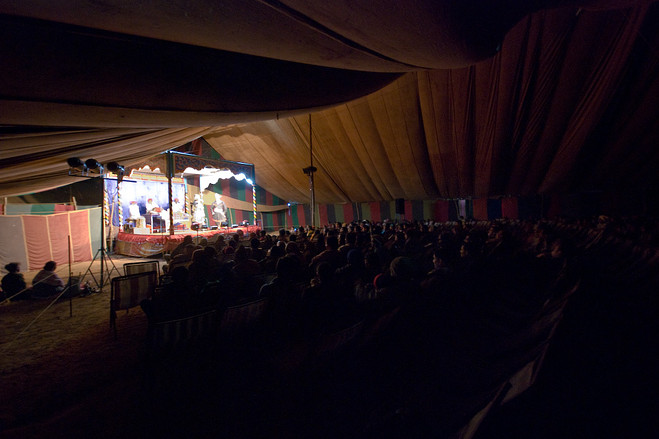
Rangabhinaya was not a new experience for fourteen-year-old Kollyuru. The original lessons about this were taught during the school days by the teacher.
While in Mittanadka primary school, when he was in the fifth grade, he was given the role of ‘Kaikeyi’ in the “Pattabhisheka” drama, written and trained by headmaster Purusha Master. It was appreciated by everyone among the locals.
Then in Kodlamogaru higher primary school, Krishnarao, a teacher at the school, cast him in a Tulu drama he had created and made him play the female role, ‘Yenkamma’. From that time on, he was known as Yenkamma. Kollyur still remember Krishna Rai, one of those revered gurus who sang to the fame of his female roles.

Vitthala Shastri had performed a new experiment of building a theatre at the ‘Lavantabettu’ ground at Moodabidri and performing the plays of Dharmasthala fair in that theatre.
Performers of the festival included Vitthala Shastri, Kaduru Ramabhatta, Kollyuru Narayana Bhatta, Hosahittilu Ganapathi Bhatta, Putturu (Manangai), Krishna Bhatta, Bannada Malinga, Kumbale Ramachandra, Bellambattu Sheena Bhandari, Kargallu Subbanna Bhatta, Aduru Ramachandra Maniyani, Appayya Maniyani etc. As Bhagavatas Putturu Eshwarappayya, Mambadi Kannanna Shetty (Music), Kollyuru Narayana Sapalya etc.
The play would go on in the venue for 45 successive days. There was a Permanent tent of the game at Sri Gopalakrishna Temple of Moodabidri. Kuriya Venkataramana Shastri took Kollyuru to the tent and handed him over to his son.
The following day itself around early afternoon, when the Muhurta was acceptable, at the time of Ganapati pooja all the seniors and artists came together, prayed to God and tied the Jingles.
Kumbale Ramachandra, a well-known rhetorician of the time, was approached to teach Kollyuru. He was a famous artist and was a disciple of Kumbale Narasimha.
It was a couple of long periods of practice, and Kollyuru was able to enter the play.
Typically, the trainees are required to perform theatre in the guise of ‘kodangi’ or ‘daurungi’, while ‘clown masquerade’ is to perform ‘eloquence’ with bizarre quirks and nonsense. The young men, balagopalas should be with them when they plough.”

But for Kollyuru it was an opportunity to enter directly as a Balagopala. He was accompanied by Appayya Maniyani who had learned dance and would put up 150 dinginas. Whereas Kollyuru used to barely put 15 dinginas, he would giggle taking a gander at Kollyuru. Additionally, the folks at the assembly would laugh at him because they thought It was entertaining.
A couple of days later came the day when he would enter the theatre. That is the role of Balakrishna, who appears to his father in the ‘Sri Krishna Leele’ episode.
This play does not require dancing. It simply needs to get on the chariot, be bold and tell what needs to be done.
The necessary words were taught by Kargallu Subbanna Bhatta who was playing female role in the Mela. Kollyuru memorized the following lines.
ವಸುದೇವ ದೇವಕಿಯರಿಂತೆಂದು ಕೈಮುಗಿದು |
ಅಸುರ ಕಂಸನ ಬಾಧೆಗೆಣೆಯಿಲ್ಲವೆಂದೆನಲು |
ಎಸೆದು ಗೋಕುಲದೊಳು ಯಶೋದೆಗಾಜೆಯಾಗಿ ಮಾಯೆಯಿಹಳೀ ನಿತಿಯಲಿ ||
ಕೊಸರುಗೊಳದನ್ನ ಕೊಂಡಲ್ಲಿರಿಸಿ ತರುತಲಾ |
ಶಿಶುವ ಕಂಸಂಗೆ ಕೊಡಿರೆನಲುಟ್ಟ ಧೋತ್ರವನು |
ಮುಸುಕಿಡಲು ಸತಿ ಪುರುಷರಿಬ್ಬರಿಗೆ ಕಾಲಸಂಕಲೆ ಕಳಚಿತಾಕ್ಷಣದೊಳು||

